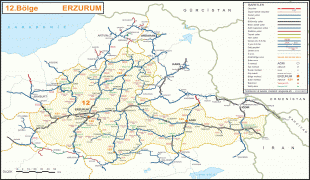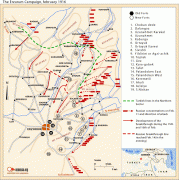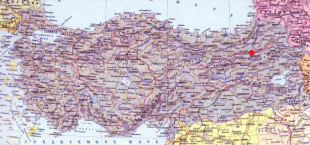Erzurum
Erzurum (Կարին; Erzirom ) is a city in eastern Anatolia, Turkey. It is the largest city and capital of Erzurum Province and is 1,900 meters (6,233 feet) above sea level. Erzurum had a population of 367,250 in 2010.
The city uses the double-headed eagle as its coat-of-arms, a motif that has been a common symbol throughout Anatolia since the Bronze Age.
Erzurum has winter sports facilities and hosted the 2011 Winter Universiade.
The city was originally known in Armenian as Karno K'aghak' (Կարնոյ քաղաք), meaning city of Karin, to distinguish it from the district of Karin (Կարին). It is presumed its name was derived from a local tribe called the Karenitis. An alternate theory contends that a local princely family, the Kamsarakans, the Armenian off-shoot of the Iranian Kārin Pahlav family, lent its name to the locale that eventually became the city.
During Roman times, Erzurum was named Theodosiopolis (Theodosiopolis, ). After the Arab conquest of Armenia in the seventh century, the city was known to the Arabs as Kālīkalā (adopted from the original Armenian name Karno K'aghak' (Կարնոյ քաղաք), meaning "Karin City", to distinguish it from the district of Karin (Կարին).
It received its present name after its conquest by the Seljuk Turks following the Battle of Manzikert in 1071. In 1048/49, a neighboring commercial city named Artze (Arcn, Arzan; Armenian: Արծն) was heavily sacked by the Seljuks. Its Armenian, Syrian, and other Christian inhabitants moved to Theodosiopolis, which they began calling "Artsn Rum" (meaning Artze of the Rûm, i.e., Romans) to distinguish it from their former residence.
Some older sources derive the name Erzurum from the Arabic Arḍ ar-Rūm (ارض الروم) "land of the Rûm."
During the brief period it came under Georgian rule, the city was known as Karnu-kalaki (კარნუ-ქალაქი).
The city uses the double-headed eagle as its coat-of-arms, a motif that has been a common symbol throughout Anatolia since the Bronze Age.
Erzurum has winter sports facilities and hosted the 2011 Winter Universiade.
The city was originally known in Armenian as Karno K'aghak' (Կարնոյ քաղաք), meaning city of Karin, to distinguish it from the district of Karin (Կարին). It is presumed its name was derived from a local tribe called the Karenitis. An alternate theory contends that a local princely family, the Kamsarakans, the Armenian off-shoot of the Iranian Kārin Pahlav family, lent its name to the locale that eventually became the city.
During Roman times, Erzurum was named Theodosiopolis (Theodosiopolis, ). After the Arab conquest of Armenia in the seventh century, the city was known to the Arabs as Kālīkalā (adopted from the original Armenian name Karno K'aghak' (Կարնոյ քաղաք), meaning "Karin City", to distinguish it from the district of Karin (Կարին).
It received its present name after its conquest by the Seljuk Turks following the Battle of Manzikert in 1071. In 1048/49, a neighboring commercial city named Artze (Arcn, Arzan; Armenian: Արծն) was heavily sacked by the Seljuks. Its Armenian, Syrian, and other Christian inhabitants moved to Theodosiopolis, which they began calling "Artsn Rum" (meaning Artze of the Rûm, i.e., Romans) to distinguish it from their former residence.
Some older sources derive the name Erzurum from the Arabic Arḍ ar-Rūm (ارض الروم) "land of the Rûm."
During the brief period it came under Georgian rule, the city was known as Karnu-kalaki (კარნუ-ქალაქი).
Map - Erzurum
Map
Country - Turkey
 |
|
| Flag of Turkey | |
One of the world's earliest permanently settled regions, present-day Turkey was home to important Neolithic sites like Göbekli Tepe, and was inhabited by ancient civilisations including the Hattians, Hittites, Anatolian peoples, Mycenaean Greeks, Persians and others. Following the conquests of Alexander the Great which started the Hellenistic period, most of the ancient regions in modern Turkey were culturally Hellenised, which continued during the Byzantine era. The Seljuk Turks began migrating in the 11th century, and the Sultanate of Rum ruled Anatolia until the Mongol invasion in 1243, when it disintegrated into small Turkish principalities. Beginning in the late 13th century, the Ottomans united the principalities and conquered the Balkans, and the Turkification of Anatolia increased during the Ottoman period. After Mehmed II conquered Constantinople (Istanbul) in 1453, Ottoman expansion continued under Selim I. During the reign of Suleiman the Magnificent, the Ottoman Empire became a global power. From the late 18th century onwards, the empire's power declined with a gradual loss of territories. Mahmud II started a period of modernisation in the early 19th century. The Young Turk Revolution of 1908 restricted the authority of the Sultan and restored the Ottoman Parliament after a 30-year suspension, ushering the empire into a multi-party period. The 1913 coup d'état put the country under the control of the Three Pashas, who facilitated the Empire's entry into World War I as part of the Central Powers in 1914. During the war, the Ottoman government committed genocides against its Armenian, Greek and Assyrian subjects. After its defeat in the war, the Ottoman Empire was partitioned.
Currency / Language
| ISO | Currency | Symbol | Significant figures |
|---|---|---|---|
| TRY | Turkish lira | ₺ | 2 |
| ISO | Language |
|---|---|
| AV | Avar language |
| AZ | Azerbaijani language |
| KU | Kurdish language |
| TR | Turkish language |

























